|
Buckles continued - the collapse of the trade
Steel buckles were the height of fashion. George III even appointed a
steel buckle maker, John Worralow of Wolverhampton. His buckles were so
fashionable and so well designed that he was soon exporting them to
France. He also supplied the crowned heads of France, Spain and Russia.
His work was not cheap - the Earl of Shrewsbury paid 180 guineas for a
set of his buttons. The trade became enormous in Wolverhampton.
Sketchley and Adams' trade directory of 1770 lists 118 lock makers. But
next to them come buckle makers with 116. The other trades are also rans
but steel toy makers are next with 30, followed by wood screw makers,
watch chain makers and chape makers. The chape makers would, of course,
have turned out enough chapes to keep many buckle makers busy; and the
steel toy makers may have included buckles in their range; and the watch
chain makers may well have been using steel. The same directory also
notes three makers of japanned buckles.
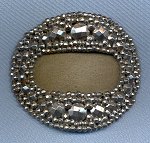 |
We have seen that Worralow also produced steel buttons.
Doubtless other local makers did too. Buttons were sometimes
produced as matching sets with shoe buckles. More often shoe
buckles had matching knees buckles, which secured the bottom
of the breeches where they met the stockings just below the
knee. But Bobby Shafto went to sea with silver buckles on
his knee - not steel ones, which maybe he could not afford.
How far other jewellery items were made in Wolverhampton is
not known. |
| Steel buckles and other jewellery are not usually
marked. Worralow sometimes put a tiny w on the back of his
pieces. Sometimes a chape maker's name appears on the chape.
But that is all. The only way Wolverhampton items can be
safely identified is by provenance and this seems to be
almost entirely lacking. (There is also a problem that the
French took up making steel jewellery, some of which can be
distinguished on stylistic grounds and some of which is
marked France or Paris; and the Germans also became large
producers). |
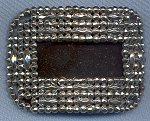 |
 |
Round about 1790 disaster hit the shoe buckle trade.
Shoe buckles became unfashionable. Shoe ties became
fashionable again. |
| Holland and Hunt record that "In 1791 a deputation of
master buckle makers, from Birmingham, Walsal [sic]
and Wolverhampton, waited upon the prince of Wales ... at
Carlton House. The object of their audience was to
present a petition, setting forth the distressed situation
of thousands of individuals in different branches of the
buckle manufacture in consequence of the the fashion then
prevailing of wearing strings. His royal highness
received the petitioners very graciously and, as proof of
his sympathy, not only resolved to wear buckles himself but
to order that his household should do the same." |
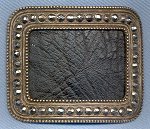 |
 |
London makers petitioned other members of
the royal family. But it was to no avail. Hutton and
Holland continue: |
| "The royal example and the royal command were alike
nugatory, when opposed to the dominion of fashion - strings
became general". Hutton says that by 1812, "the whole
generation of fashions, in the buckle line, was extinct: a
buckle was not to be found on a female foot, not upon any
foot except that of old age". It might be added that
breeches and stockings, which called for the use of knee
buckles, were also rapidly going out of fashion. |
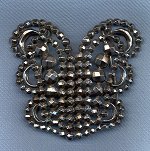 |
 |
The result was, according to Swan: "Where there were 127
buckle makers at work in Wolverhampton, 68 in Bilston and 58
in Birmingham in 1770, their numbers had halved in 1781." By
1818 he notes that "there were only 12 buckle makers in
Wolverhampton, 2 in Bilston and approximately 6 in
Birmingham". |
| The cause of this disastrous collapse is difficult to
pin down. It is noted that the army phased out shoe buckles
at about this time because they caught in the riders'
stirrups. But that hardly suffices to affect fashion - the
Navy kept their buckles until the 1850s. The time of the
collapse seems to coincide with the French Revolution, when
great ostentation in dress became unfashionable even in
England. |
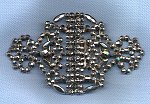 |
 |
It may also be that the fashion was played out - there
was nothing new to be done with shoe buckles and fashion
relies on what is new. Shoe ties were new and you could
enjoy yourself learning fancy ways to tie them. |
|
Shoe buckles were retained for court dress. The
Remembrancer of the City of London, flanked by the Sheriffs
of London and Middlesex, about to present a petition to
Parliament. Note that each man has buckles on his
shoes.
From Sir Benjamin Stone's Pictures, 1906.
|
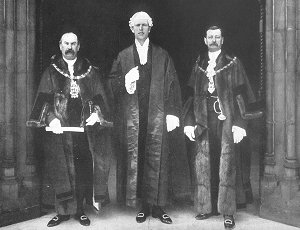 |
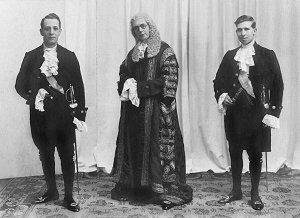 |
Closer to home this photo is thought to be of the
Recorder of Wolverhampton and may show F. A. Bosanquet, QC,
appointed 12 October 1891. He has buckles on his shows;
his "pages" have steel buttons on their jackets and cuffs, knee
buckles on their breeches and cut steel hilts to their swords. |
|
Whatever the cause of this fall in popularity, the
Wolverhampton chape and buckle makers had to find themselves
something else to do to; and they did not seem to find it too
difficult, though the post-Napoleonic economic slump would not
have helped them. George Wallis had a slightly different
view. George Wallis, one of the great Victorian art gurus, was
born in Wolverhampton in 1811. |
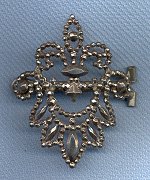 |
In 1860, writing in defence of the Wolverhampton Art
School, he talks about the cut steel industry in Wolverhampton.
Referring to "the fine steel workers of the 17th and 18th centuries" he
says: "Let them remember that 100 years ago [sc. c. 1760] a large trade
existed with France and Spain in the fine steel goods of Birmingham and
Wolverhampton, of which the latter were always allowed to be the best
both in taste and workmanship. ... A century ago French and
Spanish merchants had their houses and agencies at Birmingham for the
purchase of the steel goods of Wolverhampton. As I boy, [ Wallis
left Wolverhampton in 1832, so he is talking about a date around 1822] I
have addressed parcels to the last of these houses "Rogette et tu
Peleur". These fine steel ornaments, chains, chatelaines, sword
handles, &c., were often purchased at their weight in coined gold -
Spanish dubloons in one scale, steel goods in the other! Single
chains, by first class makers, would fetch 25 guineas. The beaus
and belles of the French and Spanish courts glittered on state occasions
in the steel ornaments of the little Staffordshire town, the skill of
whose artisans made made native iron glisten like diamonds. A relative
of my own made an inkstand in steel, which was thought worthy to be a
gift to the Queen of England. As a child I have rolled upon the
floor with rusty steel ornaments, as toys, which I would now delight to
possess as an artist. ... The Great Revolution in France put an
end to the demand for fine steel goods for a time and hostile tariffs
finished what revolution began". Wallis tended to see things in black and white: thing were
either wonderfully good or amazingly bad. And his memory might be
playing tricks and contracting dates. But the impression of a
great trade in high class goods, is clear enough - and so is its
collapse.
|

